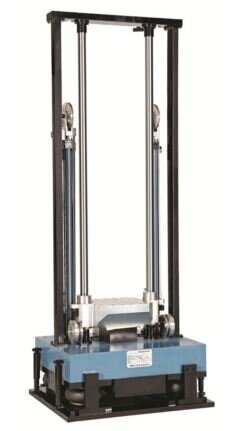Drop Shock Testing for Products and Packaging
Many products will experience shock vibration during shipping and handling or in use. These shocks may be infrequent, such as an accidental drop or repetitive, as with transportation over rough road conditions. Vibration test engineers use shock testing to simulate these conditions in the lab and confirm the structural integrity of the device.
Drop Shock Testing
Drop shock testing addresses the possibility of a non-repetitive shock. Drop tests use a classical (or basic) shock pulse to run a sharp transfer of energy into a device. Classical pulses generate a unipolar acceleration shape and a set change in velocity. Usually, a test standard will define the pulse shape(s), severity, duration, and tolerances.
Drop tests include free fall, rotational edge drop, incline/horizontal impact, and others. A shared characteristic of all drop tests is a controlled setting. The engineer should be able to reproduce the test, and parameters such as test severity and orientation are pre-defined. If the test requires the three axes of motion, the product is unmounted, re-oriented, and re-tested with the same profile.
Standards
Drop shock testing identifies product durability and/or packaging performance. Many standards within various industries require drop shock testing, including military/defense, packaging, consumer electronics, and more.
The International Electrotechnical Commission (IEC) manages several well-known drop-shock standards for electrical and electronic-related technologies, including IEC 60068-2-27, IEC 60068-2-29, and IEC 60068-2-31. IEC60068-2-27 for shock and environmental testing provides standard pulse shapes with a defined peak acceleration and duration. When possible, “the test severity and the shape of the shock pulse applied to the specimen” should either reproduce the operational environment or meet design requirements.
Amazon’s packaging standards required for vendors that use Fulfillment By Amazon (FBA) also include drop shock testing. ISTA 6-Amazon-Over Box defines a general simulation test for e-commerce fulfillment. ISTA 6-Amazon-SIOC defines a general test for Ships in Own Container (SIOC) packaged products shipped through Amazon’s distribution system to the final destination.
Other standards include SAE J1455 for automotive shock and drop testing, MIL-STD-810 for military systems, DO-106, and EN 60068-2-27.
Drop Shock Machinery
The type of machine an engineer uses to generate a classical shock pulse depends on:
Product mass
Desired amplitude
Pulse duration
Pulse shape
Drop shock machines use a product’s rapid deacceleration to generate the user-defined pulse. A drop shock machine consists of a table that is mounted on two parallel columns. The columns are raised to a pre-calculated height and then drop to the “ground”: a reaction mass that absorbs some of the shock to prevent unwanted contact with the actual ground.
TEST SET-UP
During a free-fall drop shock test, the product is mounted to a test table. The acceleration amplitude and shape of the pulse are determined by two factors: the height from which the product is dropped and the impact surface material. The height determines the overall peak acceleration; the higher it is, the greater the acceleration when the product strikes the reaction mass.
Drop shock machines can generate many of the classical shock pulses. They use components called programmers to determine the pulse shape when the table drops onto the seismic mass. The programmer is placed on top of the reaction mass that the falling table impacts.
When a machine is not tall enough to generate the desired amount of acceleration through the force of gravity, elastic bands or pneumatic cylinders can be added to increase the velocity of the impact with the programmer. The programmer is placed on top of the reaction mass where the falling table will impact. The dynamic response of the programmer determines the shape of the pulse.
ELECTRODYNAMIC SHAKERS
A drop shock machine can arrest movement using a mechanical method. An electrodynamic shaker cannot, so the engineer must set a pre-/post-pulse compensation.
A shaker can be a reliable and efficient option for routine shock testing. To run a classical shock test on a shaker, however, the pulse must start and end at zero acceleration, velocity, and displacement. Pre-/post- compensation pulses are used to drive the shaker to these zero parameters.
Building Test Profiles Using Recorded Data
When possible, the test severity and pulse shape should reflect the operational environment. Engineers can record field data and use it to build a shock pulse or compare a test profile to the recording.
The Transient Capture software from Vibration Research (VR) also offers a simple interface to record transient events. It is typically used with drop shock machines, and common applications include package testing, product life testing, and pass/fail product testing. The engineer can use the captured waveform(s) alongside the acquired data or for analysis with the shock response spectrum (SRS).
Drop Shock Vibration Test Software
Perform drop shock testing with the intuitive Shock software from VR. The software includes the standard classical shock pulses, and the engineer can vary pre/post-pulse compensation amplitude and shape. They can also select the user-defined transient option to build a pulse from a recorded waveform.
The VibrationVIEW software includes pre-defined test profiles to meet common shock test standards. The engineer can also save a new test profile for quick repeatability.
Sources: vibration research
How Can We Help You?
Interested in our Testing & Calibration services?
Send us your inquiry via the Testing & Calibration Lab Form and we will be pleased to help you.

